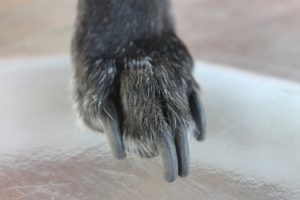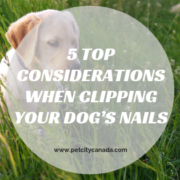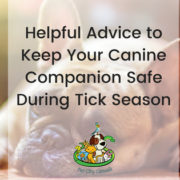5 Top Considerations When Clipping Your Dog’s Nails
Clipping your dog’s nails can be a stressful task if you are nervous about cutting them yourself. The first time clipping nails, most pet owners are afraid of injuring their pet. It is important to keep your pet’s nails short and manageable to maintain healthy paws and nail development. Ask your Veterinarian or pet groomer for the right tools to buy for the size of your dog. Here are some pointers to consider before you clip your pet’s nails for the first time.
Why is it important to keep your pet’s nails well groomed?
* To minimize the risk of nail bed infections, auto-immune disorders, and to monitor any abnormalities around the nail beds and paws.
* Maintain smooth, rounded ends; minimizing scratches on people’s skin and furniture damage.
* Shorter nails allow for better traction on pavement and flooring.
* Longer, un-kept nails can curl up and dig into the soft flesh of the pads.
* Un-kept, longer nails absorb friction and impact from the ground sending them back towards the nail beds causing sensitivity or pain.
When should you have your dog’s nails trimmed?
* Dog’s nails should be kept short enough to keep them from touching the ground while standing.
* When you hear clicking of the nails on flooring.
* When nails become torn, split, or sharp.
* Check every week to see how long your pet’s nails are. Depending on the amount and type of exercise your pet gets will determine how quickly they need trimming.
* Trimming nails after bathing is a good time since the nails will be softer. Remember to inspect the dew claws since they aren’t worn down by exposure to the ground.
How do you trim your pet’s nails to prevent bleeding?
* It is important to clip more often and take off less nail each time to allow for the blood supply and nerves to shrink back away from the nail ends.
* Gently put pressure on the paw close to the nail bed to separate the nail from the others to see clearly where you are clipping.
* Look for the quick, (the pink area within the nail that has the nerves and blood vessels), never cut too close to this area. Cut on a 45 degree angle.
* Hold the paw near the nail gently but firmly, if you feel your pet pull away don’t clip, wait till your pet is still and comfortable.
* If you do accidentally draw blood apply a blood-clotting accelerant such as Kwik-Stop or ClotIt to slow down the bleeding. Always consult a Veterinarian if bleeding doesn’t stop quickly.
What are the tools you’ll need to clip your dog’s nails?
* You may want to consider using a dremel or nail grinder instead of clippers, or a combination of both tools.
* Buy a grinder that is quiet and has variable speeds. (Trim excess fur from around dog’s paws so it doesn’t get caught in any moving pieces).
* Clippers should be concave at the cutting edge, sharp, clean, and the right size for your dog.
* Scissor and plier-style cutters are easier to use than guillotine trimmers so experiment to find the right trimmer you are comfortable using.
* Emery boards to file sharp edges, if you don’t have a dremel.
* If your dog nips at you or gets upset, you may need a muzzle for protection.
* Lots of dog treats!!
How to reassure your pet during nailing clipping?
* Start clipping your pet’s nails when they are young every week or two, taking off small amounts of nail slowly and carefully. Make sure your dog is used to having his/her paws and nails touched.
* Have treats ready for when your dog starts to get anxious. Take time to give lots of praise and petting. Stop for short periods if your dog is resisting the treatment.
* A spoonful of peanut butter on a plate will distract a puppy long enough to trim some nails if everything else fails! (Make sure peanut butter DOES NOT contain Xylitol).
If you have any reservations about how to go about clipping your dog’s nails, or are too nervous to attempt this yourself, contact Pet City Canada to book an appointment with our knowledgeable dog groomers. Our qualified staff will groom your dog and clip their nails professionally and safely.



